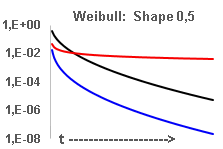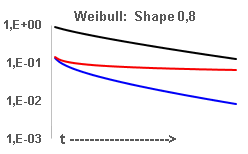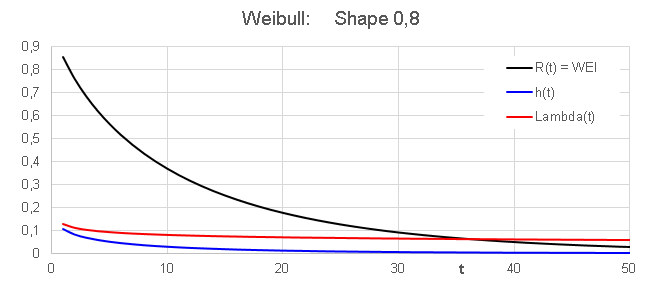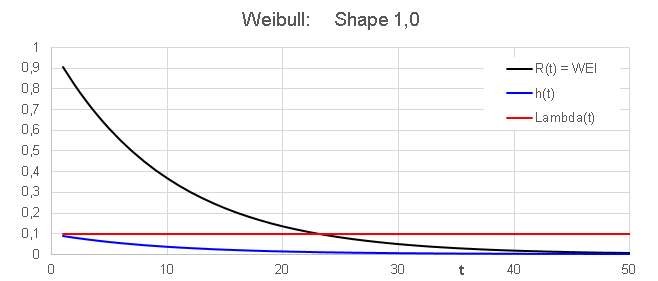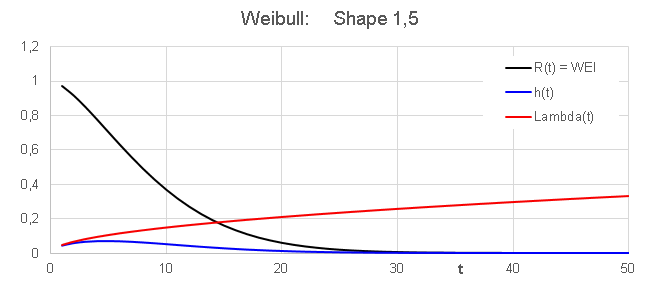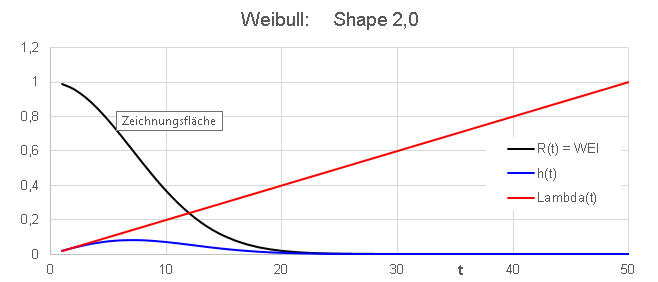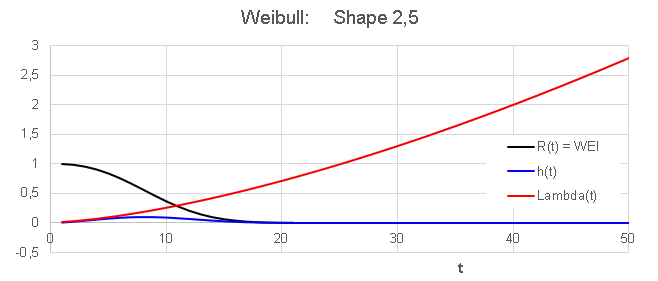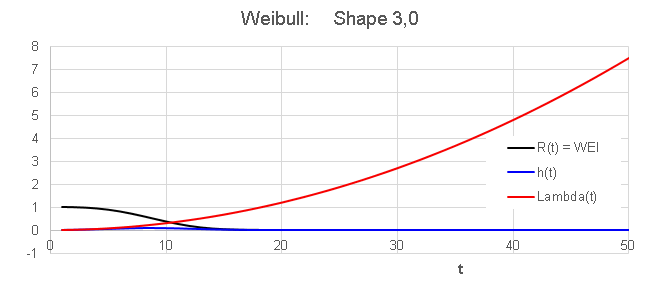
Managing
technical uncertainties
Statistics,
RAMS
& Quality Management
Search
this site  Search
this site Search
this site
|
|
|
Modeling
Reliability with the Weibull Distribution Function
| You are here:
|
Page Content
|
The Weibull distribution function is often used in reliability analysis, which is often called weibull analysis.
The Weibull distribution function is very
common in reliability analysis because its failure rate follows a power
law:
With the power law we have a simple
yet efficient vehicle in order to model various failure vs. time behavior The so called bathtub curve, which consists of
the following three phases, is a good example:
- decreasing failure rate (beta
< 0)
- constant failure rate (beta = 0)
- increasing failure rate (beta > 0)
The Weibull distribution function can
be expressed in the following
general way; it is basically an exponential function with the
exponent raised to a power:
Now we prove that the Weibull has the
stated properties. In the Weibull reliability model, R(t) becomes
WEI(t).
Here we substituted (ba)(a)b-1
by alpha and (b-1) by beta.
For the constant failure rate case,
we set b to 1, and obtain

and accordingly:

In reliability analysis, apart from the constant failure rate case (b=1
--> beta=0), the
Weibull is (only) a (admittedly useful) engineering vehicle with no
mathematical foundation. This means, the Weibull is used for the only
reason that it works well in practice.
Therefore, stating that something follows a Weibull distribution is
incorrect. Instead, it is better to state that something can be
satisfactorily modeled with the Weibull.
The weibull is a common model
for describing aging and wear-out processes.
The constant failure rate case
however is built on solid mathematical foundation, in other words, it exactly
describes certain mechanisms
occurring in nature. More on this can be found on the MTBF page.
The diagrams below show R(t), h(t)
and Lambda(t) for the Weibull for b values ("shape") between [0,5 ...
3,0],
and a fixed value for a ("scale"). b = [ 0,5 ... 3,0] covers
almost all
practical cases.
As mentioned before, the hazard rate h(t) is not important, but is
still shown for didactical reason.
Bigger and more detailed diagrams:
- The vertical scale is "true" for all
three graphs R(t), but "meaningful" only for R(t).
- Both axes are linear
- The horizontal axes are the
same for all diagrams
Smaller diagrams:
- Vertical axes are logarithmic
- The
purpose is to show the behavior for t--> 00, which is a bit tricky
with the toolset provided by MS Excel. Therefore the range of the
horizontal axes vary with the Weibull shape factor.
The first out of three phases in the bath tub
curve is called early failure
phase or infant mortality phase.
- This phase is characterized by a decreasing
failure rate Lambda(t)
- -- > Weibull with shape factor < 1
- Customers should not
be exposed to this phase.
More on the bathtub curve can be
found on the bathtub curve page
More on the three phases of the
bathtub curve can be found on the MTBF page.
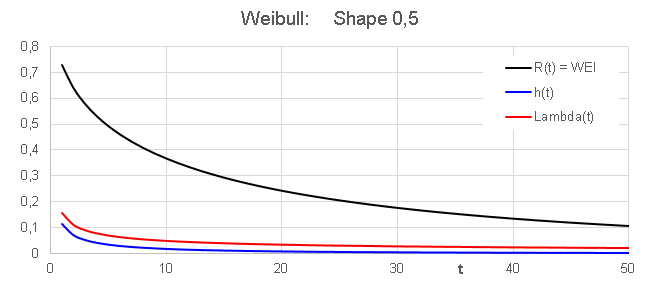
Note that all three graphs, R, h and
Lambda, are monotonically decreasing functions with time.For t-->
00, all three tend asymptotically to zero. It looks like as if the
graphs tend to zero with different "speed", but this is meaningless.
The graphs reperesent different things, and sould therefore not be
compared to each other.
Up
|
2.2
Useful Product Life Phase, Random Failures
|
Down
|
The second out of three phases in the
bath
tub curve is called useful
product life phase . 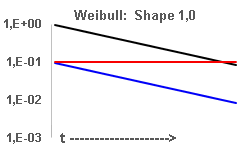
- This phase is characterized by a constant
failure rate Lambda(t)
- -- > Weibull with shape factor = 1
- Customers should be
exposed only to this
phase.
- The constant failure rate case is actually a strong achievement
every supplier and manufacturer should strive to.
More on the bathtub curve can be
found on the bathtub curve page .
The Weibull with shape factor 1 is
also called Exponential. The exponential distribution is the foundation
of the powerful concept of MTBF. Much more on this, in particular the
consequences and implications of constant failure rate, can be found on
the MTBF page.
The Weibull with shape factor 1 and
the Gamma with form factor 1 are identical distribution functions.
The Gamma plays a role in reliability
analysis too:
Gammak
describes how
long it takes for k random events
to occur.
--> The Gamma1
= Exponential describes how
long it takes for 1 random event
to occur.
The third out of three phases in the bath tub
curve is called wear-out phase. 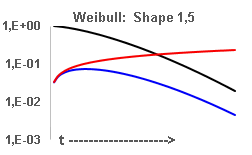
- This phase is characterized by a increasing
failure rate Lambda(t)
- -- > Weibull with shape factor > 1
- Customers should not
be exposed to this phase.
More on the bathtub curve can be
found on the bathtub curve page
More on the three phases of the
bathtub curve can be found on the MTBF page.
- R(t) and h(t) are monotonically
decreasing functions with time.For t-->
00,
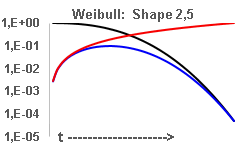 h(t) and Lambda(t) tend
asymptotically to zero. It looks like as if
the latter two tend to zero with different "speed", but this is
meaningless.
The graphs reperesent different things, and sould therefore not be
compared to each other.
h(t) and Lambda(t) tend
asymptotically to zero. It looks like as if
the latter two tend to zero with different "speed", but this is
meaningless.
The graphs reperesent different things, and sould therefore not be
compared to each other.
- Lambda(t) is a
monotonically increasing function with time. In fact, lambda tends to
infinity for t--> infinity. In order to make this appear not too
weird, we just need a population of infinite size. Mathematitians would
see no reason to bother. For the reliability engineer however it is
clear that the failure rate Lambda would increase only as long as there
are units that can fail, but as soon as the last unit of the population
has failed, Lambda would suddenly drop to zero.
The Weibull with shape factor 2 is
also called Rayleigh. Simply put, the Rayleigh distribution
can be conceived as the integral of the two dimensional Normal
distribution. However, this is meaningless in reliability analysis.
Next Topic
Privacy Policy










